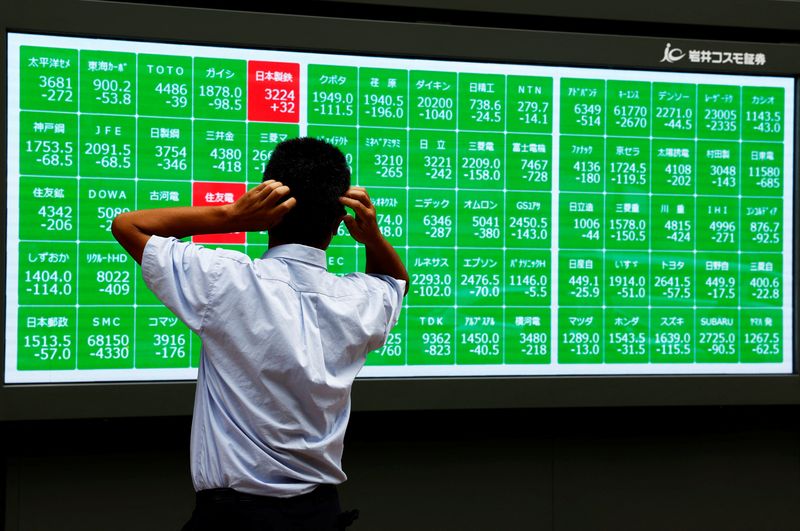By Kevin Buckland
TOKYO (Reuters) – Asian stocks slumped on Wednesday as a sharp rise in U.S. bond yields unnerved investors ahead of key inflation data that could inform the pace of Federal Reserve policy easing.
Short-term Treasury yields jumped to the highest since late July overnight as the market reopened after the Veterans Day holiday, spurring the U.S. dollar to a more than three-month peak versus the yen in the latest session.
Bond yields have soared since Donald Trump was elected back to the White House last week on expectations lower taxes and higher tariffs will push up the fiscal deficit and increase government borrowing. Trump’s proposed policies are also seen by analysts as fuelling inflation, potentially impeding the path to lower Fed interest rates.
Those same expectations had propelled U.S. stocks to record highs, but the rally stalled overnight as bond yields rose.
“It all continues to be a part of the Trump trade, which, at its core, is about deeper deficit spending,” said Kyle Rodda, a senior financial markets analyst at Capital.com.
“However, as has proven the case in other market melt-ups, a tug-of-war eventually emerges between stocks and bonds, as higher risk-free rates strangle valuations.”
Bitcoin inched back toward its all-time high from overnight just below $90,000, with markets betting on Trump to usher in an easier regulatory environment after pledging to make the United States “the crypto capital of the planet”. It last traded at around $88,195.
Commodities were broadly weaker as traders worried about the outlook for key consumer China, which stands to bear the brunt of Trump’s threatened trade tariffs. Stimulus announcements from Beijing so far have failed to stir much optimism over an economic revival.
Hong Kong’s Hang Seng slid 0.9% as of 0147 GMT, with a subindex of mainland Chinese property stocks slumping 1.3%. China’s blue chips were flat.
Japan’s Nikkei and South Korea’s Kospi sagged 1.1% and 1.2%, respectively, while Australia’s stock benchmark fell 1.1% under the weight of commodity shares.
U.S. S&P 500 futures also pointed about 0.1% lower following a 0.3% decline overnight.
The two-year Treasury yield stood at 4.34% after leaping to 4.367% on Tuesday for the first time since July 31. The 10-year yield hovered around 4.43%, not far from the four-month high of 4.479% reached a week ago in the immediate aftermath of Trump’s sweeping victory.
The dollar edged up to as high as 154.94 yen for the first time since July 30 before last changing hands at 154.56 yen.
That put the currency pair, which tends to track long-term U.S. yields, on the cusp of the 155 yen per dollar level that many market participants consider a trigger point for verbal intervention by Japanese authorities.
Japan’s finance ministry currency czar Atsushi Mimura said last week that officials “are ready to take appropriate actions if necessary when excess moves are seen.”
The U.S. dollar index – which measures the currency against the yen, euro and four other top rivals – stood at 105.92, not far from Tuesday’s high of 106.17, the strongest level since May 1.
Traders currently lay 60% odds for the Fed to cut rates by a quarter point on Dec. 18 at the conclusion of its next policy meeting, according to CME Group’s (NASDAQ:CME) FedWatch Tool. A week earlier, the probability was 77%.
A hot reading of the U.S. consumer price index (CPI) later in the day could see those odds reduced further, with economists projecting a 0.3% monthly rise in the core gauge.
The euro changed hands at $1.0625, after dipping to $1.0595 overnight, a one-year trough.
Europe, like China, is seen as hurting more under Trump tariffs, with the incoming U.S. President previously saying the bloc would “pay a big price” for not buying enough U.S. exports.
Copper prices slumped 2% to the lowest in two months on Tuesday on the London Metal Exchange.
Crude oil continued to wallow near the lowest levels this month after OPEC on Tuesday cut its forecast for global oil demand growth this year and next, highlighting weakness in China and some other regions.
Brent futures edged up 0.2% to $72 a barrel, while U.S. West Texas Intermediate (WTI) crude added 0.2% to $68.26, not straying far from Tuesday’s lows, which were the weakest levels since Oct. 30.
Gold attempted to find its feet, rising 0.4% to around $2,607 per ounce, following its slump to a nearly two-month low of $2,589.59 in the previous session, pressured by dollar strength.



